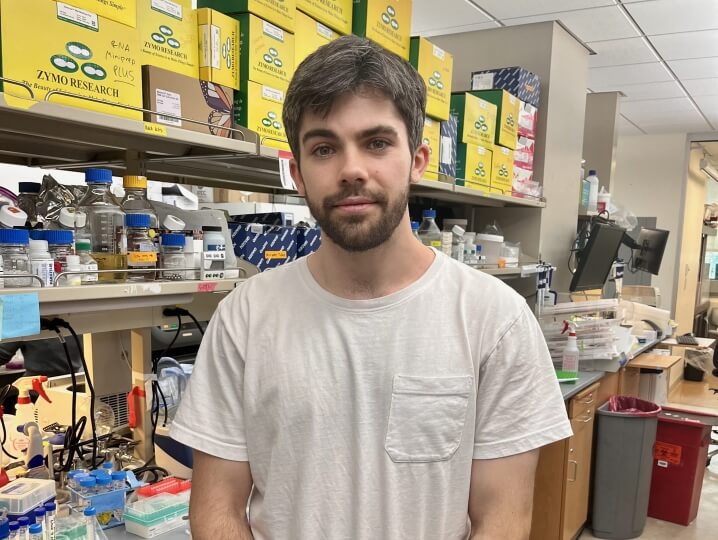Teagan Stedman, S.B. '22
When Teagan Stedman was 8 years old, a close friend was diagnosed with Non-Hodgkin's Lymphoma. A budding musician, Stedman organized a rock concert to fundraise for pediatric cancer research. That experience changed his life.
“A lot of the support we got was from sponsorships from businesses around the area, and sometimes it was difficult to get taken seriously as a kid,” said Stedman, S.B. '22. “This was in 2008, which was not a good time economically for a lot of businesses because of the recession. That was the main point of resistance as a kid, but there were companies like Guitar Center that were super supportive.”
That one concert grew into an official 501(c)(3) non-profit two years later, which Stedman called Shred Kids’ Cancer. By the time Stedman closed the non-profit in 2024, it had raised over $500,000 to support nine clinical trials at hospitals in Boston and L.A.
“It’s amazing to me that it got to the level of energy and involvement and sheer number of people that it did,” he said. “That was a really great time in my life, and I feel a lot of pride.”
It also inspired Stedman to study bioengineering, which eventually led him to the Harvard John A. Paulson School of Engineering and Applied Sciences (SEAS). Stedman is now a Ph.D. student in nutritional and metabolic biology at the Columbia University Irving Medical Center, where he’s doing synthetic biology research that could, among other applications, help suppress the spread of cancerous tumors.
“I didn’t necessarily know exactly what my undergraduate education would look like in the beginning, or how it would be helpful,” he said. “I learned a lot of crucial lessons on how to think like an engineer, how to think about things through a mathematical lens. The bioengineering curriculum set me up to think about problems the right way, and that was my motivation for choosing it in the first place.”
A desire for a well-rounded education brought Stedman to Harvard, which is where he first came across the idea of synthetic biology. He became an undergraduate researcher in the lab of Pam Silver, Elliot T. and Onie H. Adams Professor of Biochemistry and Systems Biology at Harvard Medical School, and also joined the winter bootcamp for Harvard’s International Genetically Engineered Machine (iGEM) team, a SEAS-sponsored student organization that undertakes synthetic biology products for an annual competition. As part of iGEM, he helped develop genetic tools which could be used to detect failure in tissue grafts used in coronary artery bypass surgery. He eventually became Harvard iGEM’s Education Chair.
“Synthetic biology is a framework where biology is made easier to build and engineer by rigorously characterizing biological systems,” Stedman said. “The label can be applied to a lot of different projects, but the main principle of most of them is about harnessing our power to read and write DNA to solve biological problems.”
After leaving SEAS, Stedman spent a year doing pathogen and cell death research at Massachusetts General Hospital, then joined Columbia’s Wang Lab in the fall of 2024. At Columbia, Stedman’s research centers on the role of amino acids in health, disease and evolutionary history. Of the 20 amino acids incorporated into proteins, humans and most other animals can’t produce nine on their own, and must consume them through diet. Stedman is trying to engineer tissue and cells that can produce those amino acids on their own, which could then be used in a therapeutic setting.
“One use case for this is that scientists have been able to deplete one essential amino acid from a test animal’s diet just enough to suppress the growth of a tumor, but without losing much overall body weight,” he said. “Tumors need lots of these amino acids, because they’re making lots of proteins and prioritizing growth. At the same time, immune cells are also doing lots of proliferation in response to disease, which also requires a lot of amino acids. So one application I’m considering is modifying CAR-T immune cells with these pathways. If you can combine a specific amino acid depletion with the ability for the CAR-T cells to make their own amino acids, you could have this synergistic boost to the immune response while also suppressing the growth of the tumor.”
Between the pandemic making big events difficult and Stedman wanting to focus on school, Shred Kids’ Cancer went quiet in the 2020s. He closed it in 2024, donating the last of the non-profit’s funds. But even if his non-profit days are now behind him, Stedman can always look back on that first rock concert as the foundation of all the work he’s done since.
“I’d become interested in science to some degree before that, but Shred Kids’ Cancer fed into me wanting to use science to develop therapeutics,” he said. “It’s the main reason I wanted to pursue bioengineering.”
Press Contact
Matt Goisman | mgoisman@g.harvard.edu
